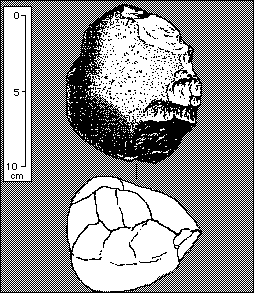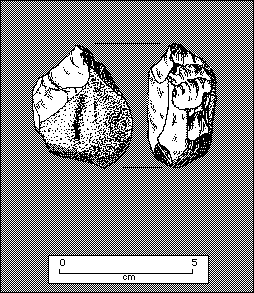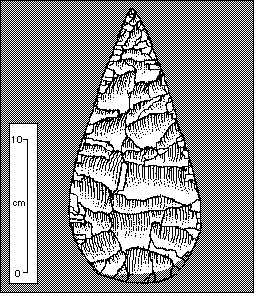 Side Chopper from Site DK at Olduvai Gorge
Side Chopper from Site DK at Olduvai GorgeIn this section you will be introduced to some of the earliest stone tool technologies, such as those found at Olduvai Gorge. You will also be provided with information on some more advanced techniques for making stone tools. The stone tool technologies covered in this section include:
The very first stone tools were probably naturally broken, sharp-edged rocks that were casually picked up, used and discarded. There is probably no way that we will ever know how long this type of behavior persisted in hominid prehistory.
At some point, however, early hominids began purposely selecting specific raw materials, and making their own sharp-edged stone tools. The earliest manifestation of this behavior has been called the Pebble Tool Tradition, because it entailed the sharpening of pebbles and small cobbles through the bifacial (two-sided) removal of flakes. Although it was thought for years that the sharpened pebbles were the desired end product; new evidence from the analysis of microscopic wear patterns on the flakes that had been considered waste products indicates that the flakes may actually have been the tools, used for general purpose cutting.
 Side Chopper from Site DK at Olduvai Gorge
Side Chopper from Site DK at Olduvai Gorge
Note the way in which this piece has been bifacially flaked to produce a sharp ridge along the right side and both ends. This is a fairly typical example of what have been termed pebble tools. Note also how it appears to have been battered along the mid portion of the right side.
The Chopper-Chopping Tool Tradition
The Chopper-Chopping Tool Tradition was a logical outgrowth of the Pebble Tool Tradition. The primary goal of the Pebble Tool Tradition was probably the manufacture of sharp edged flakes. The cores, however, would also have been useful as heavy chopping tools. It is the regular diversification of the toolkit, incorporating tools made of sharp flakes and shaped core chopping tools that defines the boundary between the Pebble Tool Tradition and the Chopper-Chopping Tool Tradition. The latter had an extreme longevity, particularly in what are now China and Southeast Asia - about 1.5 million years without a significant change in technology!
 Chopper from Site DK at Olduvai Gorge
Chopper from Site DK at Olduvai Gorge
Note how much more heavily worked this specimen is compared to the side chopper illustrated previously. This piece is also bifacially worked, but to a much more regular sharp edge on the upper left in the side view (left image).
The Acheulean Handaxe Tradition
The next major technological advance in the production of stone tools is exhibited in the Acheulean Handaxe Tradition. Although the number of different types of tools used by peoples employing the Acheulean handaxes also increased compared to the Chopper-Chopping Tool Tradition, the real hallmark of the handaxe tradition is the craftsmanship and efficiency displayed in the production of the handaxes themselves.
The progressive refinement of lithic tool production, changing techniques to produce more cutting edge per unit of raw material, really becomes obvious when comparing the two earliest traditions to this one. This trend of increasing the efficiency of tools and raw material use characterizes the shift between major tool traditions. The Acheulean Tradition had a great longevity, also on the order of 1.5 million years, but was more confined to Africa, the Middle East, and western and central Europe.
 Late Stage European Acheulean Handaxe
Late Stage European Acheulean Handaxe
Note the excellent control exhibited in the shaping of this tool. Also note that all of the cortex has been removed. Finally, compare the amount of effective cutting edge on this tool to the amount of effective cutting edge on the large pebble chopper illustrated in that section. This technique is clearly an improvement in efficiency as well as technique.
The Acheulean Handaxes were made in very much the same way that the other two types of tools were manufactured. That is, they were produced by bifacial flaking using the hard hammer technique for initial shaping. A soft hammer technique was then used for final shaping and to produce a thin, sharp cutting edge. The last step was more common in the latter portion of the time period when these tools were being manufactured. The real distinction in the manufacture of these tools is the higher degree of selectivity in the choice of raw material, more control in the shaping of the tool, and the removal of larger, thinner shaping/thinning flakes.
If you are working on Assignment 4-2, then you should return to the Exercise menu, by clicking on the "Main" button below, to continue at this point. You have just been introduced to the basic principles of lithic technology. The techniques and the major tool types illustrated in this exercise have all been found in the deposits at Olduvai Gorge. We hope that this introduction will help you in the exercises that follow.
|
|
|
|